

Victorian Britain. 7 Ways Victorian Fashion Could Kill You. Want to be the smartest person in the room at this year's Super Bowl party?

Bust out a few of these fun facts about Big Games past. 1. Super Bowl Sunday is the second biggest eating day of the year. According to the U.S. Department of Agriculture, Super Bowl Sunday is America's "second-largest food consumption day. " 2. Kanjana intaounwong/iStock via Getty Images A persistent rumor says that sewage systems in major cities occasionally fail during Super Bowl halftimes, because a large volume of people supposedly all flush their toilets simultaneously. 3. Donald Miralle/Getty Images Peyton Manning is the only starting quarterback to win a Super Bowl with two different teams: the Indianapolis Colts in 2007 and the Denver Broncos in 2016. 4.
Allsport/Getty Images Phil Simms was paid $75,000 to shout "I'm going to Disney World” on the field moments after his Giants won Super Bowl XXI. 5. Jamie Squire, Getty Images 6. Jeff Zelevansky, Getty Images Which team has lost the most? 7. FREDERIC J. 8. 9. (37) The Victorian Way. From quills to typewriters: how the industrial revolution changed our writing culture. Documents written centuries ago are fascinating, revealing not only the thoughts of those who wrote them but a history of how they were written.
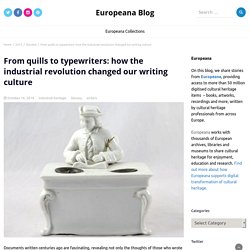
This blog looks at the changes in the way we have expressed our thoughts through the written word since the industrial revolution. The industrial revolution brought about a shift from an economy based on agriculture and handicrafts to one focused around large industries and factory systems. Alongside this, increased need for written documentation developed. During this period, new technologies and materials changed writing practices, in private as well as in the workplace. Writing with quills For centuries, feathers had been the most popular writing tool. Turning a feather into a working quill required other tools, such as a small knife to cut the feather and produce its narrow end.
Industrial Revolution Sources. British Pathé. Industrial Revolution in Britain: Resources. Revolutionary Players: The people, ideas & innovations that shaped the modern world. Lives - Lives - London Lives. Biographies Compiled using London Lives London Lives contains enough documentary material to reconstruct the lives, or significant portions of the lives, of hundreds of thousands of Londoners who lived in the eighteenth century, including both plebeians and the officers who manned the institutions of government and social welfare.
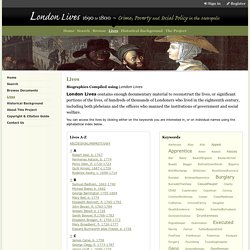
You can access the lives by clicking either on the keywords you are interested in, or on individual names using the alphabetical index below. Lives A-Z Robert Abel, b. 1767 Parmenas Adcock, b. 1774. Public health and epidemics in the 19th and 20th centuries. 2.

Essential information You can search our catalogue for relevant records using keywords and dates. However, because the catalogue descriptions of these records are not very detailed it can be difficult to identify the right keywords to find the documents you want. The printed current guide, available on site at Kew, can be used to identify useful keywords relating to this or other subjects. Poverty and the Poor Laws. Use this guide for advice on how to locate Poor Law records at The National Archives, as well as documents in which issues of and connected to poverty are discussed more broadly.
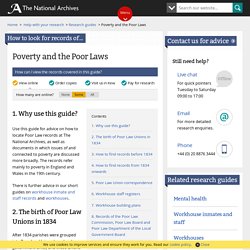
The records refer mainly to poverty in England and Wales in the 19th century. 2. The birth of Poor Law Unions in 1834 After 1834 parishes were grouped into Poor Law Unions (new local government units) and these unions reported to the newly created Poor Law Commission, later the Poor Law Board, and later again, the Poor Law Department of the Local Government Board, all based in London. Each Poor Law Union was run by a board of guardians elected by ratepayers from their constituent parishes. Prize-Winning Animation Lets You Fly Through 17th Century London. Six students from De Montfort University have created a stellar 3D representation of 17th century London, as it existed before The Great Fire of 1666.

The three-minute video provides a realistic animation of Tudor London, and particularly a section called Pudding Lane where the fire started. As Londonist notes, "Although most of the buildings are conjectural, the students used a realistic street pattern [taken from historical maps] and even included the hanging signs of genuine inns and businesses" mentioned in diaries from the period. The bloody clash that changed Britain. On the morning of 16 August 1819, an immense crowd poured into Manchester, perhaps the largest the town had ever seen.
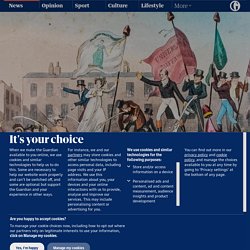
They came in an orderly and peaceful fashion. Banners bearing slogans such as “Liberty and Fraternity” and “Taxation without Representation is Unjust and Tyrannical” flapped in the breeze, and bands played patriotic tunes including Rule Britannia and God Save the King. It was a fine and sunny day. On they came in cheerful mood; organised contingents from Bolton and Bury; 6,000 marching from Rochdale and Middleton; others from Saddleworth and Stalybridge; 200 women dressed in white from Oldham, together with families bringing their children and picnics with them. INDUSTRIAL REVOLUTION. SEE ALSO, Europe Transformed Author: Lewis Hackett Date: 1992 Industrialization: The First Phase Most products people in the industrialized nations use today are turned out swiftly by the process of mass production, by people (and sometimes, robots) working on assembly lines using power-driven machines.
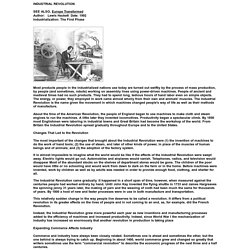
People of ancient and medieval times had no such products. They had to spend long, tedious hours of hand labor even on simple objects. Internet History Sourcebooks. Industrial Revolution See Main Page for a guide to all contents of all sections.
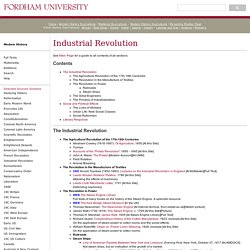
Contents The Industrial Revolution The Agricultural Revolution of the 17th-18th Centuries The Revolution in the Manufacture of Textiles The Revolution in Power Railroads Steam Ships The Great Engineers The Process of Industrialization Social and Political Effects The Lives of Workers Urban Life: New Social Classes Social Reformism Literary Response The Industrial Revolution The Agricultural Revolution of the 17th-18th Centuries Abraham Cowley (1618-1667): Of Agriculture, 1650 [At this Site] Turnips Accounts of the "Potato Revolution" 1695 - 1845 [At this Site] John A. Mazis: The Potato [Modern Account][At UMN] Field Rotation Animal Breeding The Revolution in the Manufacture of Textiles 2ND Arnold Toynbee (1852-1883): Lectures on the Industrial Revolution in England [At McMaster][Full Text] Leeds Woolen Workers' Petition, 1786 [At this Site] Attacking the effects of machinery.
Industrial Revolution. Industrial Revolution. Victorian Social History: Sitemap. History - Women's Work. Untitled Document. Now that we have looked at how and why the Industrial Revolution occurred, it’s time to consider its effects on people.
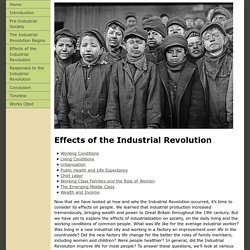
We learned that industrial production increased tremendously, bringing wealth and power to Great Britain throughout the 19th century. But we have yet to explore the effects of industrialization on society, on the daily living and the working conditions of common people. What was life like for the average industrial worker? Images of the Industrial Revolution. Industrial Revolution - Facts & Summary. The textile industry, in particular, was transformed by industrialization. Before mechanization and factories, textiles were made mainly in people’s homes (giving rise to the term cottage industry), with merchants often providing the raw materials and basic equipment, and then picking up the finished product.
Workers set their own schedules under this system, which proved difficult for merchants to regulate and resulted in numerous inefficiencies. In the 1700s, a series of innovations led to ever-increasing productivity, while requiring less human energy. For example, around 1764, Englishman James Hargreaves (1722-1778) invented the spinning jenny (“jenny” was an early abbreviation of the word “engine”), a machine that enabled an individual to produce multiple spools of threads simultaneously.
By the time of Hargreaves’ death, there were over 20,000 spinning jennys in use across Britain. Water Power and the Industrial Revolution: Denis Smith. Top 10 Industrial Revolution Inventions. The Industrial Revolution -- an innovative period between the mid-18th and 19th centuries -- thrust people from a predominantly agricultural existence into a more urban lifestyle. Although we label this era a "revolution," its title is somewhat misleading. The movement that first took root in Great Britain wasn't a sudden burst of advancement, but rather a buildup of breakthroughs that relied on or fed off one another.
Just as the dot-coms were integral to the 1990s, inventions were what made this epoch unique. Without all those soaring, ingenious minds, many of the basic goods and services we use today wouldn't exist. Whether adventurous souls dared to tinker with existing inventions or to dream of something brand-new, one thing's for sure -- the revolution changed the lives of many people (yours included). The Industrial Revolution - Innovations. Agricultural Revolution The Agricultural Revolution is the name given to the drastic changes in the farming process that occurred in the 1600's onwards. The spread-out, shared farms, common under the "open-field system" of cultivation, turned into more compact, but larger, farms.
The many problems associated with open fields; the overgrazing of animals, difficulty in reaching consensus for change, and single herds that had led to a spread of animal diseases and uncontrollable breeding breeding; had all become generally solved (Gernhard). The Railroad Journey and the Industrial Revolution: Crash Course World History 214. Coal, Steam, and The Industrial Revolution: Crash Course World History #32.
BBC Bitesize - KS3 History - The triangular slave trade - Revision 1. Child labour. Industrialisation led to a dramatic increase in child labour. Professor Emma Griffin explores the dangerous, exhausting work undertaken by children in factories and mines, and the literary responses of writers including Charles Dickens and Elizabeth Barrett Browning. Child labour was not an invention of the Industrial Revolution. The Industrial Revolution. In this article Matthew White explores the industrial revolution which changed the landscape and infrastructure of Britain forever. The 18th century saw the emergence of the ‘Industrial Revolution’, the great age of steam, canals and factories that changed the face of the British economy forever. Early industry Early 18th century British industries were generally small scale and relatively unsophisticated. Most textile production, for example, was centred on small workshops or in the homes of spinners, weavers and dyers: a literal ‘cottage industry’ that involved thousands of individual manufacturers.
Inventing the Future. BBC Bitesize - GCSE History - The Industrial Revolution Class Clips, Page 1. Victorian Children in trouble with the law. GCSE Bitesize: Living conditions in cities. BBC Bitesize - KS3 History - Everyday life in the Industrial Era - Revision 1. The East India Company: How a trading corporation became an imperial ruler. Au.pinterest. The Great Exhibition. Dickens's London: in pictures. MyNoise Online Noise Generators. Britain's child slaves: New book says their misery helped forge Britain. By Annabel Venning for MailOnline Updated: 14:03 GMT, 17 September 2010 The tunnel was narrow, and a mere 16in high in places. The workers could barely kneel in it, let alone stand. Thick,choking coal dust filled their lungs as they crawled through the darkness, their knees scraping on the rough surface and their muscles contracting with pain.
A single 'hurrier' pulled the heavy cart of coal, weighing as much as 500lb, attached by a chain to a belt worn around the waist, while one or more 'thrusters' pushed from behind. Many would die from lung cancer and other diseases before they reached 25. Robert North, who worked in a coal mine in Yorkshire, told an inspector: 'I went into the pit at seven years of age. Impoverished: Children who worked were subject to appalling conditions. Another young hurrier, Patience Kershaw, had a bald patch on her head from years of pushing carts - often with her scalp pressed against them - for 11 miles a day underground.
Living conditions were appalling. The Industrial Revolution and the Railway System.